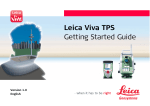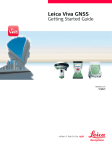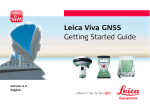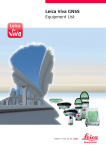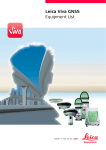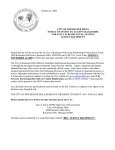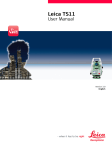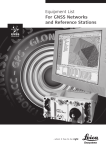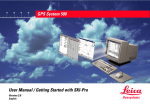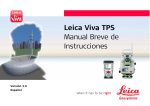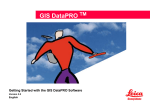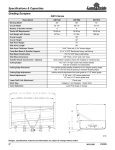Download Leica Viva GNSS Getting Started Guide
Transcript
Leica Viva GNSS Getting Started Guide Version 1.0 English 2 Viva GNSS, Introduction Introduction Purpose of this manual Quick references to specific topics To use the product in a permitted manner, please refer to the detailed safety instructions in the Leica CS10/CS15 User Manual and the Leica GS10/GS15 User Manual. For detailed descriptions of all functions and settings of the product and applications, please refer to the Leica Viva Series Technical Reference Manual. This Getting Started Guide is intended as a quick field reference manual for immediately getting started with your Leica Viva Series equipment. The manual explains what you can find in your container, how everything fits together and how to get started on the basic applications. Topic Refer to What’s in my container? Chapter 1.1 How does the equipment all fit together? Chapter 1.2 What is this first screen I see when I turn on my instrument? Chapter 2.1 How do I get to the Main Menu? Chapter 2.1 How do I select things and move around the screens? Chapter 2.2 What are wizards? Chapter 2.2 How do I get started with jobs and codelists? Chapter 3 Topic Refer to How to use the applications? Chapter 4 myWorld@Leica Geosystems (https://myworld.leica-geosystems.com) offers a wide range of services, information and training material. With direct access to myWorld, you are able to access all relevant services whenever it is convenient for you, 24 hours a day, 7 days per week. This increases your efficiency and keeps you and your equipment instantly updated with the latest information from Leica Geosystems. Service Description myProducts Simply add all Leica Geosystems products that you and your company own. View detailed information on your products, buy additional options or Customer Care Packages (CCPs), update your products with the latest software and keep up-to-date with the latest documentation. myService View the service history of your products in Leica Geosystems Service Centers and detailed information on the services performed on your products. For your products that are currently in Leica Geosystems Service Centers view the current service status and the expected end date of service. Viva GNSS, Introduction 3 4 Viva GNSS, Introduction Service Description mySupport Create new support requests for your products that will be answered by your local Leica Geosystems Support Team. View the complete history of your Support and view detailed information on each request in case you want to refer to previous support requests. myTraining Enhance your product knowledge with the Leica Geosystems Campus - Information, Knowledge, Training. Study the latest online training material or download training material on your products. Keep up-to-date with the latest News on your products and register for Seminars or Courses in your country. Table of Contents In this manual Chapter 1 Equipment 1.1 1.2 1.3 1.4 1.5 1.6 2 Page Container Contents Setting up as a Post-Processing Base Setting up as a Real-Time Base Setting up as a Real-Time Rover Using the Backpack Fixing the CS to a Holder and Pole SmartWorx Viva and Principles 2.1 2.2 2.3 Viva GNSS, Table of Contents SmartWorx Viva 2.1.1 Screen 2.1.2 Icons 2.1.3 Main Menu Operating Principles Webserver 2.3.1 Home 2.3.2 Icons 2.3.3 Go to Work! - Wake-Up 7 7 11 16 23 31 34 38 38 40 43 47 50 54 54 56 57 5 6 Viva GNSS, Table of Contents 2.3.4 2.3.5 2.3.6 3 Jobs & Data 3.1 3.2 3.3 4 Current Status Instrument User Creating a New Job Creating a Codelist Importing ASCII Data into a Job Applications 4.1 4.2 4.3 Survey Stakeout Reference Line Appendix A A.1 A.2 Working with Memory Devices Formatting a Memory Device Directory Structure of the Memory Device 58 59 60 61 61 63 67 71 72 75 80 83 83 85 Appendix B Uploading System Files 87 Appendix C Leica Geo Office 89 1 Equipment 1.1 Container Contents Container for GS10 instrument and delivered accessories part 1 of 2 a SYS13_21 Viva GNSS, Equipment f b g h c d e i j a) GS10 instrument b) Single/double arm for antennas of devices c) GFU device such as radio d) Antennas of device e) GAD32 telescopic rod f) GEB221 batteries g) Height hook h) Cables i) Antenna and GAD31 adapter j) SD cards 7 8 Viva GNSS, Equipment Container for GS10 instrument and delivered accessories part 2 of 2 a SYS_022 j b c d e k fg h l m n i a) CS15 field controller b) GHT62 holder for CS field controller on pole c) Allen key d) Supplied stylus e) GHT36 base for telescopic rod f) CS10 field controller g) GHT62 holder for CS field controller on pole h) GAD33 arm 15 cm i) GFU device such as radio j) Manual & DVD k) Tribrach l) GRT247 carrier m) GEB211/GEB212 battery n) GHT63 clamp Container for GS15 instrument and delivered accessories part 1 of 2 a f g SYS13_17 Viva GNSS, Equipment b h c i d e j a) b) c) d) e) f) g) h) i) j) GDC221 car adapter GS15 instrument Cables Tribrach Manuals and DVD TNC QN-adapter GAD31 adapter GS15 instrument GRT247 carrier SD cards 9 10 Viva GNSS, Equipment Container for GS15 instrument and delivered accessories part 2 of 2 ab c d e f g a) b) c) d) e) f) g) SYS_018 h i j k l GAD108 arm GAD34 arm 3 cm GHT36 base for telescopic rod GEB211/GEB212 batteries Allen key CS field controller GHT62 holder for CS field controller on pole h) Antennas of device i) GAD32 telescopic rod j) Height hook k) GHT63 clamp l) Supplied stylus 1.2 Setting up as a Post-Processing Base Use The equipment setups described following are to be used for static operations over markers. Description The instrument can be programmed with the CS field controller before use which can then be omitted from the setup. • • • GNSS antenna/GS15 instrument is mounted directly using screw fitting. If using stub and adapter, procedures can vary slightly. When using the adapter and carrier, ensure that the GNSS antenna and the adapter assembly slide down the full length of the carrier stub. An incorrectly mounted GNSS antenna will have a direct effect on the results. GNSS antennas are AS05 or AS10. Procedures/setup can vary if AR25/AT504GG is used. If the instrument is left in the container during use in high temperatures, the lid should be left open. Refer to the GS10/GS15 User Manual for operating and storage temperatures. Use an external battery such as GEB171 to ensure operation for a full day. Viva GNSS, Equipment 11 12 Viva GNSS, Equipment Equipment setup GS10 a b c d e f g h i j k l m n GS_107 a) b) c) d) e) f) g) h) i) j) k) l) m) n) GNSS antenna AS05/AS10 GRT247 carrier Height hook Tribrach 2.8 m antenna cable GS10 instrument Tripod GEB221 batteries SD card SD card CompactFlash card CS field controller GEB211/GEB212 battery Transport container Equipment setup GS15 a h b c d e f g i j k l m GS_111 Viva GNSS, Equipment a) b) c) d) e) f) g) h) i) j) k) l) m) GS15 instrument Height hook GRT247 carrier Tribrach Tripod CS field controller Hand strap Transport container SD card GEB211/GEB212 batteries SD card CompactFlash card GEB211/GEB212 battery 13 14 Viva GNSS, Equipment Equipment setup step-by-step Step Description 1. Set up the tripod. 2. Mount and level the tribrach on the tripod. 3. Ensure that the tribrach is over the marker. 4. Place and lock the carrier in the tribrach. GS10 GS15 5. Screw the GNSS antenna onto the carrier. Insert the SD card and the batteries into the GS15. 6. Check that the tribrach is still level. Press the ON/OFF button on the GS15 for at least 2 s to switch on the GS15. 7. Insert the batteries into the instrument. Screw the GS15 onto the carrier. 8. Insert the SD card into the instrument. Check that the tribrach is still level. 9. Connect the instrument to the GNSS Insert the SD card or CompactFlash antenna using the antenna cable and card and the battery into the CS field port ANT on the instrument. controller. 10. Connect the CS field controller to the instrument if necessary. Step Description Viva GNSS, Equipment 11. To hang the instrument on the tripod leg, use the hook on the rear of the unit. Or place the instrument in the container. To hang the CS field controller on the tripod leg, use the hook on the hand strap. Refer to the CS10/CS15 User Manual. 12. Insert the height hook into the carrier. 13. Measure the antenna height using the height hook. 14. Press the ON/OFF button on the instrument for at least 2 s to switch on the instrument . 15 16 Viva GNSS, Equipment 1.3 Setting up as a Real-Time Base Use The equipment setups described following are to be used for real-time base stations with the need of normal radio coverage. Raw observation data can also be collected for post-processing. Description The GS10 instrument clips to the tripod leg. Connections are made to the GNSS and radio antenna. The radio antenna is mounted on the antenna arm which clips to the GNSS antenna. The GS10/GS15 instrument can be programmed with the CS field controller before use which can then be omitted from the setup. The GS10 instrument can be used as a DGPS base station, if fitted with the DGPS option, and as a real-time base station. The connection between GS15 and CS field controller is made via Bluetooth. • • GNSS antenna/GS15 instrument is mounted directly using screw fitting. If using stub and adapter, procedures can vary slightly. When using the adapter and carrier, ensure that the GNSS antenna and the adapter assembly slide down the full length of the carrier stub. An incorrectly mounted GNSS antenna will have a direct effect on the results. • • Standard radio is used throughout the instructions. Digital cellular phones can also be used but the setup can differ slightly. GNSS antennas are AS05 or AS10. Procedures/setup can vary if AR25/AT504GG is used. If the instrument is left in the container during use in high temperatures, the lid should be left open. Refer to the GS10/GS15 User Manual for operating and storage temperatures. Use an external battery such as GEB171 to ensure operation for a full day. Viva GNSS, Equipment 17 18 Viva GNSS, Equipment Equipment setup GS10 a k b a) b) c) d) e) f) g) c d e l m f g n h) i) j) k) l) h i o p j q r GS_108 m) n) o) p) q) r) Radio antenna GAD33 arm 15 cm GNSS antenna AS05/AS10 Height hook GRT247 carrier Tribrach 1.2 m antenna cable (instrument/GNSS antenna) Tripod GS10 instrument Radio in housing Transport container 1.2 m antenna cable (radio housing/radio antenna) GEB221 batteries SD card SD card CompactFlash card CS field controller GEB211/GEB212 battery Equipment setup GS15 a h b c d e f g i j k l m GS_111 Viva GNSS, Equipment a) GS15 instrument with built-in radio b) Height hook c) GRT247 carrier d) Tribrach e) Tripod f) CS field controller g) Hand strap h) Transport container i) SD card j) GEB211/GEB212 batteries k) SD card l) CompactFlash card m) GEB211/GEB212 battery 19 20 Viva GNSS, Equipment Equipment setup step-by-step Step Description 1. Set up the tripod. 2. Mount and level the tribrach on the tripod. 3. Ensure that the tribrach is over the marker. 4. Place and lock the carrier in the tribrach. GS10 GS15 5. Screw the GNSS antenna onto the carrier. Insert the SD card and the batteries into the GS15. 6. Check that the tribrach is still level. Press the ON/OFF button on the GS15 for at least 2 s to switch on the GS15. 7. Insert the SD card and the batteries into the instrument. Screw the GS15 onto the carrier. 8. Connect the instrument to the GNSS Check that the tribrach is still level. antenna using the antenna cable and port ANT on the instrument. 9. Connect the CS field controller to the Insert the SD card or CompactFlash instrument if necessary. card and the battery into the CS field controller. Step Description Viva GNSS, Equipment 10. To hang the instrument on the tripod Connect the CS field controller to the leg, use the hook on the rear of the instrument if necessary. unit. Or place the instrument in the container. 11. Insert the height hook into the carrier. 12. Measure the antenna height using the Insert the height hook into the height hook. carrier. 13. Clip the antenna arm to the GNSS antenna. Measure the antenna height using the height hook. 14. Screw the radio antenna onto the antenna arm. Press the ON/OFF button on the instrument for at least 2 s to switch on the instrument. 15. Attach the radio in its housing to port P2 or P3 on the instrument. 16. Connect the radio antenna to the radio using the second 1.2 m antenna cable. To hang the CS field controller on the tripod leg, use the hook on the hand strap. Refer to the CS10/CS15 User Manual. 21 22 Viva GNSS, Equipment Step Description 17. Press the ON/OFF button on the instrument for at least 2 s to switch on the instrument. - 1.4 Setting up as a Real-Time Rover Use The equipment setups described following are to be used for real-time rover with extended periods of use in the field. Description The radio attaches to the GS10 instrument and is placed in the backpack. Connections are made to the GNSS antenna, radio antenna and CS field controller. The cables coming from the backpack can be disconnected when an obstacle such as a fence has to be crossed. The CS field controller is fixed to the pole with the GHT62. Connection between the GS15 instrument and the CS field controller is made via Bluetooth. • • • Viva GNSS, Equipment GNSS antenna/GS15 instrument is mounted directly using screw fitting. If using stub and adapter, procedures can vary slightly. When using the pole with stub, ensure that the GNSS/GS15 instrument antenna and the screw-to-stub adapter slide down the full length of the stub before tightening the locking ring. An incorrectly mounted GNSS/GS15 instrument antenna will have a direct effect on the results. Aluminium poles are used. They can be replaced with their carbon fibre equivalent without any change to these instructions. 23 Viva GNSS, Equipment • • 24 Standard radio is used throughout the instructions. Digital cellular phones can also be used but the setup can differ slightly. GNSS antennas are AS05 or AS10. Procedures/setup can vary if AR25/AT504GG is used. Equipment setup a i j b k f c g h l d e m n o p GS_101 Viva GNSS, Equipment a) b) c) d) e) f) g) h) i) j) k) l) m) q r n) o) p) q) r) GNSS antenna AS05/AS10 Pole CS field controller Grip for pole GHT62 holder Antenna cable SD card CompactFlash card Radio antenna GAD34 arm 3 cm Telescopic rod Backpack 1.2 m antenna cable (radio housing - radio antenna) 1.8 m, CS to GS10 cable Radio in housing GEB221 batteries SD card GS10 instrument 25 26 Viva GNSS, Equipment Equipment setup a b f g h i c j d k e GS_110 a) b) c) d) e) f) g) h) i) j) k) GS15 instrument Built-in radio Grip for pole GHT62 holder Pole SD card GEB211/GEB212 batteries SD card CompactFlash card CS field controller GEB211/GEB212 battery Equipment setup step-by-step Step Description 1. Attach the GHT62 holder to the pole. Refer to "1.6 Fixing the CS to a Holder and Pole". 2. Insert the SD card or CompactFlash card and the battery into the CS field controller. 3. Clip the CS field controller into the holder and lock it by pushing the locking pin into the locked position. 4. Press ON/OFF button on the CS field controller to switch on. Proceed with step 5. for GS10 and with step 24. for GS15. Viva GNSS, Equipment 5. Screw the GNSS antenna to the top of the pole. 6. Insert the SD card and the batteries into the instrument. 7. Attach the radio in its housing to port P2 or P3 on the instrument. 8. Place the instrument in the backpack with the top side facing outwards and the instrument front panel to the top. 9. Fasten the strap around the instrument. 10. Push the telescopic rod through the slit in the top of the backpack. Ensure that it is located in the sleeve inside the backpack and push it all the way to the bottom. 11. Adjust the height of the telescopic rod to suit. 27 28 Viva GNSS, Equipment Step Description 12. Screw the radio antenna arm onto the telescopic rod. 13. Connect the first 1.2 m antenna cable to the radio antenna. 14. Pass the cable through the opening in the top of the backpack and down underneath the instrument. 15. Connect the first 1.2 m antenna cable to the radio. 16. Connect the 1.6 m antenna cable to port ANT on the instrument. 17. Pass the 1.6 m antenna cable through a cable brake and down through the opening in the bottom corner of the backpack flap. Refer to "Position of cables in the backpack". 18. Draw the required amount of cable out of the backpack and tighten the cable brake. 19. Connect one end of the second 1.2 m antenna cable to the loose end of the 1.6 m antenna cable and the other end to the GNSS antenna. 20. Connect the 1.8 m, CS to GS cable to the CS field controller. 21. Pass the 1.8 m, CS to GS cable through the opening in the bottom corner of the backpack flap and up through a cable brake. Refer to "Position of cables in the backpack". 22. Plug it into port P1 on the instrument. Step Description 23. Press ON/OFF button on the instrument to switch on. GS15 Viva GNSS, Equipment 24. Insert the SD card and the batteries into the GS15. 25. Press ON/OFF button on the GS15 to switch on. 26. Screw the GS15 to the top of the pole. 27. CS field controller and GS15 are connected via Bluetooth. 29 30 Viva GNSS, Equipment Position of cables in the backpack c a b GS_112 a) 1.6 m antenna cable b) 1.8 m cable to connect CS field controller and GS instrument c) 1.2 m antenna cable to connect radio housing and radio antenna Refer to "1.5 Using the Backpack" for advice on using the backpack. 1.5 Using the Backpack Use The backpack is used for various applications. The applications are: • Post-processed kinematic, pole and backpack. • Real-time rover, pole and backpack. Ensures that the antenna pole does not sway around and remains as upright as possible. Antenna pole strap Pass the strap around the pole and fasten using the clip as shown in the diagram. GS_105 Viva GNSS, Equipment 31 Viva GNSS, Equipment 32 The hip belt • transfers most of the weight from the shoulders to the hips when properly adjusted. • contains velcro attachments through which cables can be passed. Hip belt GS_102 The internal net pouch is designed for • carrying an AS05/AS10 antenna when not in use. • storing coiled cables. • carrying a non-standard radio. • carrying spare batteries. • carrying sandwiches. Internal net pouch GS_103 Use in high temperatures In high temperatures, it is desirable to increase air flow around the instrument. Therefore the backpack can be kept half or even fully open when in use. GS_104 GS_106 To 1) 2) 3) Viva GNSS, Equipment half open the backpack: Open the backpack halfway. Tuck the flap inside. Secure it with the velcro pad. To 1) 2) 3) open the backpack completely: Open the backpack completely. Secure it with the velcro pad. Tuck the flap under the instrument. 33 34 Viva GNSS, Equipment 1.6 Fixing the CS to a Holder and Pole Components of the GHT62 holder The GHT62 holder consists of some components, as shown in the diagram. d e f g a h i b c GHT63 clamp a) Plastic sleeve b) Pole clamp c) Clamp bolt GHT62 holder d) Locking pin e) Top clip f) Mounting plate (extendable) g) Bottom clip h) Tightening screw i) Mounting arm TS_058 Fixing the CS field controller and GHT62 to a pole step-by-step Step 1. Description If you use the CS15 field controller, extend the mounting plate of the holder first. For an aluminium pole, fit the plastic sleeve to the pole clamp. Insert the pole into the clamp hole. Step Description 2. Attach the holder to the clamp using the clamp bolt. 3. Adjust the angle and the height of the holder on the pole to a comfortable position. 4. Tighten the clamp with the clamp bolt. 5. Before the CS field controller is placed onto the mounting plate, ensure that the locking pin is put into the unlocked position. To unlock the locking pin, push the locking pin to the left. 6. Hold the CS field controller above the holder and lower the end of the CS field controller into the mounting plate. TS_055 Viva GNSS, Equipment 35 36 Viva GNSS, Equipment Step Description 7. Apply slight pressure in a downward direction and then lower the top part of the CS field controller until the unit is clicked into the holder. The guides of the mounting plate aid in this action. 8. After the CS field controller is placed onto the mounting plate, ensure that the locking pin is put into the locked position. To lock the locking pin, push the locking pin to the right. TS_056 TS_054 Detaching the CS from a pole step-by-step Step Description 1. Unlock the locking pin by pushing the locking pin to the left of the mounting plate. 2. Place palm over the top of the CS until fingers grip the bar of the holder underneath. 3. Push from the top of the CS toward the bar of the holder. 4. While in this position, lift the top of the CS from the holder. 1 2 TS_057 Viva GNSS, Equipment 37 38 Viva GNSS, SmartWorx Viva and Principles 2 SmartWorx Viva and Principles 2.1 SmartWorx Viva Keyboard display CS15 F1 F2 a b c d e f g F3 j k l m n F6 F5 F4 OK Fn 1 h 2 3 4 5 6 7 8 F12 F8 F11 F9 Q W A i E S Z R D X F10 T F C o 9 . 0 F7 V B K J H N M P O I U Y G L p q r CS_006 a) b) c) d) e) f) g) h) i) j) k) l) m) n) o) p) q) r) Home Arrow keys, OK ON/OFF Fn ± key Numeric keys Brightness Function keys F7 - F12 CAPS Lock Function keys F1 - F6 Favourites ESC ENTER Backspace Volume Alpha keys ENTER SPACE Start using SmartWorx Viva • • Turn on your CS field controller and start SmartWorx Viva. Turn on your GS GNSS or TPS instrument. For information about wizards refer to "Wizards". Viva GNSS, SmartWorx Viva and Principles 39 40 Viva GNSS, SmartWorx Viva and Principles 2.1.1 Screen - CS15 field controller Screen a b f c g h i d e SYS13_025 Elements Element a) b) c) d) e) f) g) h) i) Description Time The current local time is shown. Title Name of the screen is shown. Screen area The working area of the screen. Message line Messages are shown for 10 s. Icons Title Screen area Message line Softkeys ESC Fn CAPS Time Element Description Icons Shows status information of the instrument. Refer to "2.1.2 Icons". Can be used with touch screen. ESC Can be used with touch screen. Same functionality as the fixed key ESC. The last operation will be undone. Entry mode The caps mode for upper case letters is active. The caps mode is activated and deactivated by pressing the CAPS key. Fn Switches between the first and second level of function keys. Softkeys Commands can be ran using F1-F6 keys (only applicable for CS15 field controller). The commands assigned to the softkeys are screen-dependent. Can be used directly with touch screen. Viva GNSS, SmartWorx Viva and Principles 41 42 Viva GNSS, SmartWorx Viva and Principles Common softkeys The softkeys following are used commonly in the Leica SmartWorx Viva software across all applications. Softkey Function Key Description OK (F1) To select the highlighted option and to continue with the subsequent screen. Page (F6) To change to another page on the current screen. Help Fn (F1) To open the Leica SmartWorx Viva online help. Home Fn (F2) To move the focus to the top of the list shown in the current screen. End Fn (F3) To move the focus to the bottom of the list shown in the current screen. Quit Fn (F6) To exit the current application and return to the screen from where the application was accessed. 2.1.2 Icons Description The screen icons display the status information of the instrument. Icon bar - GNSS Mode The icons provide information related to basic instrument functions. The icons that appear depend upon which instrument is used and the current instrument configuration. a b c d e f g h i SYS13_023 a) GNSS position status b) Number of visible satellites c) Number of satellites contributing to position solution d) Real-time device and real-time status, Internet online status e) Current active instrument Viva GNSS, SmartWorx Viva and Principles f) Camera g) Line/area/auto points h) Memory storage (SD card/CompactFlash card/USB stick/internal memory) i) Battery level (field controller/instrument) 43 44 Viva GNSS, SmartWorx Viva and Principles Icons Icon Description Position status Displays the status of the current position. As soon as this icon becomes visible the instrument is in a stage where practical operation can commence. Number of visible satellites Displays the number of theoretically visible satellites above the configured cut-off angle according to the current almanac. Contributing satellites Displays the number of satellites that are contributing to the currently computed position solution. The number of contributing satellites can differ from the number of visible satellites. This difference can be because satellites cannot be viewed, or because the observations to these satellites are considered too noisy to be used. Real-time device Displays the real-time device configured to be used. Icon Description Real-time status Displays the status of the real-time device configured to be used. Current active instrument Displays the instruments that are currently configured and active. When more than one instrument is configured, the instrument at the front of the icon is the active instrument. Camera Select this icon to begin the camera function. Data management Select this icon to open the data management pages for Points, Lines or Areas. If there are open lines or areas, a symbol will appear in the icon. Memory storage Displays the status of the internal memory or data storage device. Viva GNSS, SmartWorx Viva and Principles 45 46 Viva GNSS, SmartWorx Viva and Principles TPS specific icons Icon Description Battery Displays the status and location of the battery. Icon Description Automatic aiming Displays the current automatic aiming or PowerSearch settings. Prism Displays the selected prism. Measure mode Displays the selected measurement mode. The red laser icon will display when the red laser is active. Compensator level and Displays the compensator is off or out of range icons, or Instrument face I or II the instrument face I or II icon. 2.1.3 Main Menu Main Menu OK To select the highlighted option and to continue with the subsequent screen. Fn Mode To switch between GPS and TPS modes Fn Exit To close Leica SmartWorx Viva software. Main Menu functions Main Menu function Description Go to Work! • To select and start an application. Viva GNSS, SmartWorx Viva and Principles 47 Viva GNSS, SmartWorx Viva and Principles Main Menu function 48 Description Jobs & Data • To manage jobs, data, codelists, GNSS antennas, reflectors and coordinate systems. • To export data from a job on the instrument to a file on the memory device in a customised ASCII format or in DXF format. • To import ASCII, GSI or DXF data from a file on the memory device to a job on the instrument. • To copy points between jobs. Instrument • To access all configuration parameters related to a survey, the instrument and the interfaces. Main Menu function Description User • To format the memory device. • To upload files relevant for the instrument functionality, for example, firmware files, language files and licence keys. • To transfer data between the memory device and a standard and simple FTP server. • To view files on the memory device or the internal memory. Viva GNSS, SmartWorx Viva and Principles 49 50 Viva GNSS, SmartWorx Viva and Principles 2.2 Accessing a menu option Operating Principles Description Illustration There are three ways to access a menu option. 1 Using the touchscreen functionality. Tap on the menu item using the stylus provided. 2 Using the up and down navigation arrows. Move the focus to the menu item. Select OK, or press the OK button, or the ENTER button. OK 3 Using the numbered keypad. Select the number that corresponds to the menu item. For example, press 1 from the Jobs & Data menu to access the New job screen. Accessing a selectable list Description Illustration A downward arrow beside a field, indicates there are more choices available in a selectable list. A box and a downward arrow beside a field, indicates that there are more choices and functionality available in a separate screen. To access the list or screen use the touchscreen functionality to tap on the icon, or move the focus to the field and press the ENTER button. Accessing a page within a screen Description Illustration To access another page within a screen, either: • Tap on the page tab for the page to be displayed, or • Select Page until the page is displayed Viva GNSS, SmartWorx Viva and Principles 51 52 Viva GNSS, SmartWorx Viva and Principles Exiting a screen without making a change Wizards Description Illustration To exit a screen without making a change, either: • Tap on the return icon, or • Press the ESC button The wizards following are available to make your daily work easier. Each of them lead you through a serious of steps, performing tasks in a specific sequence. For detailed descriptions of the wizards, please refer to the Leica Viva Series Technical Reference Manual. Wizard Description SmartWorx StartUp Wizard Define the behaviour of your instrument for a general start-up. RTK rover wizard Set up your real-time rover. TPS connection wizard Connect your CS field controller with your TPS instrument. Wizard Description Working style wizard Configure the parameters and functions of SmartWorx Viva so that it suits to your preferred method of working and save the settings in a working style. Viva GNSS, SmartWorx Viva and Principles 53 54 Viva GNSS, SmartWorx Viva and Principles 2.3 Webserver Description The Web server is a web-based tool to view the status of and configure the GNSS instruments. The Web server application is integrated into the GS firmware and cannot be deleted. Access The Web server from the GNSS instruments can be accessed using the web browser of a Windows device. The Windows device has to be connected first to the GNSS instrument via cable or Bluetooth. Refer to the Leica GS10/GS15 User Manual. 2.3.1 Home Description Home function Description Go to Work! • To select and start the Wake-up application. Refer to "2.3.3 Go to Work! - Wake-Up". Home function Description Current Status • To view GNSS information of the GS as well as the instrument firmware. Refer to "2.3.4 Current Status". Instrument • To configure settings for the GS. Refer to "2.3.5 Instrument". User • Viva GNSS, SmartWorx Viva and Principles To upload and activate firmware, licence keys and languages. Refer to "2.3.6 User". 55 56 Viva GNSS, SmartWorx Viva and Principles 2.3.2 Icon bar Icons a b c d e f SYS13_029 a) b) c) d) e) f) GNSS position status Number of satellites tracked and available for each satellite system Real-time device and real-time status Internet online status Memory storage (SD card only) Battery level on GS 2.3.3 Go to Work! - Wake-Up Description Wake-up sessions are static point occupations, for which the instrument is preprogrammed with a start time and a duration or end time. The instrument turns itself on at the configured start time and the point occupation begins. The point occupation stops and the point is stored after the preprogrammed duration. In the Go to Work! - Wake-Up menu, the actions following can be performed: • Create/edit a Wake-up session. • Activate/deactivate a Wake-up session. • Delete a Wake-up session. A data storage device must be inserted when the instrument wakes up. If no data storage device is fitted or it is damaged, not formatted or full then the session will not be run. Viva GNSS, SmartWorx Viva and Principles 57 Viva GNSS, SmartWorx Viva and Principles 58 2.3.4 Current Status Description In the Current Status menu, the statuses following can be viewed: • Satellite Tracking status – Date and time of the various almanacs on the instrument – Sat, Elevation, Azimuth, S/N1 and S/N2 and Health of every satellite • Position status – Local time, Position latency, HDOP, VDOP, GDOP, PDOP, Position quality and Height quality (only available if a calculated position is available) • Battery/memory/raw data logging status – Percentage of remaining power capacity of the internal and/or external battery (if connected) – Total/free memory for data storage on the SD card – Information about the raw data logging • Instrument status – Instrument and firmware (e.g. Serial no.) – Version (e.g. firmware version of the onboard software) – Licencing (e.g. availability of additional instrument hardware options) 2.3.5 Instrument Description In the Instrument menu, the actions following can be performed: • Set Operating mode (base or rover), select antenna • Configure Raw data logging and Auto logging of points • Configure Satellite settings • Configure Coordinate system settings • Define Time settings Viva GNSS, SmartWorx Viva and Principles 59 Viva GNSS, SmartWorx Viva and Principles 60 2.3.6 User Description In the User menu, the actions following can be performed: • Load firmware – Upload new firmware on the GS instrument. • Load licence key – Load a licence key to or delete a licence key from the instrument. A licence key activates the application or the protected options or the software maintenance on the instrument. Licence key files use the naming convention L_123456.key, where 123456 is the instrument serial number. • Language management – Select the interface language of the Web server. English is always available as the default language of the Web server and cannot be deleted. 3 Jobs & Data 3.1 Creating a New Job Creating a job step-by-step General steps to create your first job in SmartWorx Viva. Creating your first job • From the Main Menu, select Jobs & Data and press OK. • Viva GNSS, Jobs & Data Select New job from the Jobs & Data menu and press OK. 61 62 Viva GNSS, Jobs & Data • • • Enter a name for the job. Use Page to toggle between the pages to set the proper Codelist, CAD files, Coord system, TPS scale and Averaging. Press Store to save the job. You have finished creating your first job, which is selected as current working job. You will automatically return to the Main Menu and are ready to start the next activity. 3.2 Creating a Codelist Creating a codelist step-by-step Generals steps to create your first codelist in SmartWorx Viva. Creating your first codelist • From the Main Menu, select Jobs & Data and press OK. • Viva GNSS, Jobs & Data Select Job properties from the Jobs & Data menu and press OK. 63 64 Viva GNSS, Jobs & Data • • Press Page to change to the Codelist page. Tap on the selectable list to open the Codelists screen. • Press New.. to create a codelist. • Type in a Name (Description and Creator are optional). Press Codes.. to open the Codes screen. • Creating a code • Press New.. to create a code. • Type in a Code (EL) and a Description (Light Pole), select the Code group* (Electric), the Code type (Point) and the Linework (None) and create an attribute (Diameter). Press Store to save the new code. • * The Code group has to be created first before it can be selected. Press OK to return to the New Codelist screen. • Viva GNSS, Jobs & Data 65 66 Viva GNSS, Jobs & Data Storing the codelist • Press Store to save your codelist. You will automatically return to the Codelists screen. • • Press OK to return to Job Properties:, Codelist page. Press Store to save your job and to return to the Main Menu. You have created your first codelist, with a code and a code group and attached it to your current working job. 3.3 Importing ASCII Data into a Job Objective Importing point objects into the working job by using the Import ASCII data functionality. At least one ASCII file with any file extension must be stored in the \DATA directory of the internal memory or data storage device. Import ASCII data step-by-step Starting the ASCII Importer • From the Main Menu, select Jobs & Data. • Viva GNSS, Jobs & Data In the Jobs & Data menu, select Import data, then Import ASCII data and access the Import ASCII Data screen. 67 68 Viva GNSS, Jobs & Data • • Select the data storage device, the data type (ASCII data), the file to be imported, the working job into which the data has to be imported and define whether header lines have to be considered. Enter the Configuration screen (Config..). Configuring the ASCII Importer • Select the Delimiter. • Define the position for Point ID, Easting, Northing, Height and Code (if applicable). • Confirm the configuration settings and return to the Import ASCII Data screen (OK). • Enter the Define Ht Type & Easting Import screen (Fn Hts..). Define height type and Easting import • Define how heights (Orthometric or Ellipsoidal) and how the Easting is imported. • Confirm the configuration settings and return to the Import ASCII Data screen (OK). Importing the ASCII data • Import the ASCII data to the working job (OK). • Viva GNSS, Jobs & Data After importing the ASCII data to the working job, complete the import (No) and return to the Main Menu or import another ASCII data (Yes). 69 70 Viva GNSS, Jobs & Data You have completed importing ASCII data into your current working job. 4 Applications Getting started Viva GNSS, Applications • Check that the correct working style (see User, Working style wizard) is being used. • Check that the correct working job (see Jobs & Data, Choose working job) is being used. 71 72 Viva GNSS, Applications 4.1 Survey Objective Surveying point objects (fire hydrants, light poles etc.) by choosing codes manually. Surveying point objects step-by-step Starting Survey • In the Go to Work! menu, select Survey and access Survey. • Switch to the Code page. Selecting the code • Highlight Code and select the code EL (for Electric Light pole). To select the code EL, toggle to the code or type in the letters to open the drop-down list and search for the code. You have to enter capitals. Measuring the point object • When the code is selected, press Meas to measure the point object. • • Viva GNSS, Applications After the measurement has been stopped the Enter Mandatory Attribute screen will appear since the attribute Diameter is mandatory and is currently blank. Enter a diameter of 300 (mm) and press OK to store the point. 73 74 Viva GNSS, Applications You have finished measuring your first point object. Once the point is stored then the code and attribute value that was stored are displayed. 4.2 Stakeout Objective Staking out point objects. To make your life easier you will define a filter before staking out the point object. The filter will be defined the way that only points with a certain code and those points which have not yet been staked will be available to be staked out. To accelerate the working example, skip the steps regarding the filters and proceed directly with staking out the point object. Staking out point objects step-by-step Viva GNSS, Applications Starting Stakeout • In the Go to Work! menu, select Stakeout and access Stakeout. 75 76 Viva GNSS, Applications Choose Control Job • Select the job which contains your point objects to be staked out. • Press OK to enter the Stakeout screen. Configuring Stakeout • Press Fn Config.. to access the Configuration screen. • Configure the following settings: • General page, Quality control page and Report sheet page: Leave all settings unchanged. • Heights page: Check Offset height of all points being staked and set Height offset to 0.000 m. Graphics page: Set Navigate direction: Following arrow and Navigate using: In/out, left/right. Press OK to return to the Stakeout screen. • • Setting up filters • Tap on the box with the downward arrow right of the Point ID to open the Data screen. All points stored in the control job are shown. • Viva GNSS, Applications Press Fn Filter.. to access Sorts & Filters screen. 77 78 Viva GNSS, Applications • • Set Filter by: Point code. Press Codes.. to access Point Code Filter screen. • • • Press None to set all codes to No. Highlight code EL and press Use to activate it. Press OK to return to the Sorts & Filters screen. • Press Stake to access Stakeout Filter screen. • • Set View: Points to stake. Press OK three times to return to the Stakeout screen. Staking out your first point object • Which is the closest point to you to stake out first? Press Near to select the nearest point. • Navigate to the point and press Meas. • • While measuring the point you still can see the differences between the coordinates of the design point and the coordinates of the point you measured. The next point in the list to be staked out is displayed after the point was stored. You finished staking out your first point. Viva GNSS, Applications 79 80 Viva GNSS, Applications 4.3 Reference Line Objective Measuring or staking point objects (fire hydrants, light poles etc.) relative to a reference line. Measuring point objects relative to a reference line step-by-step Starting Measure to ref line • In the Go to Work! menu, select Survey+ and access Survey+ menu. Staking a reference line can also be accessed under Go to Work! / Stakeout+ / Stake to ref line. • Select Measure to ref line and continue (OK). Define the Reference line task • Set Reference line task: Measure to line and continue (OK). Choose Control Job • Select the job which contains the points used to define the reference line. • Press OK to access Reference Line To Use screen. Define the reference line to be used • Set Create line using: 2 points • Select a Start point • Select an End point • Press OK to access Measure Points screen. Viva GNSS, Applications 81 82 Viva GNSS, Applications Measure the point object relative to the reference line • In the Measure Points screen, press Meas to measure the point. You have finished measuring your first point object relative to a reference line. Appendix A Working with Memory Devices A.1 Formatting a Memory Device General Formatting a memory device before storing data on it, is required if the device is new, or if all data on the device must be deleted. By activating the format command all data will be lost. Make sure that all important data on the device has been backed up before formatting. If formatting the internal memory, make sure that all important data is first transferred to the computer. Formatting the memory device will make it incompatible with System 1200 instruments. To become usable with System 1200 again, the device would need to be reformatted on a System 1200 instrument. To exit the screen without formatting the memory device, press the ESC key. This returns to the previous screen without running the format command. Viva GNSS, Working with Memory Devices 83 84 Viva GNSS, Working with Memory Devices Formatting a memory device step-by-step • From the Main Menu, select User\Tools & other utilities\Format data storage devices • • Memory Device: Select the device to format Select OK to continue with the formatting. • Select Yes to complete the formatting of the memory device, OR Select No to cancel formatting of the memory device and return to Format Data Storage Device. Once the formatting of the memory device is completed the system returns to the Main Menu. • • A.2 Directory Structure of the Memory Device Directory structure |—— | |—— | |—— | |—— | | | | | | | | | | | |—— | CODE • Codelists, various files CONFIG • Working style files (*.xfg) CONVERT • Format files (*.frt) DATA | | | |—— GPS | |—— CSCS | |—— GEOID | |—— RINEX | DBX | • • ASCII, DXF, LandXML files for import/export to/from job (*.*) Report sheets created from applications • CSCS field files (*.csc) • Geoid field files (*.gem) • RINEX files • • DTM jobs, various files Coordinate system file (Trfset.dat) Viva GNSS, Working with Memory Devices 85 86 Viva GNSS, Working with Memory Devices | | |—— | |—— | | | |—— | | |—— |—— JOB | DOWNLOAD • GPS • • • Job files, various files. Jobs are stored in a folder per job. Various files, downloaded by Field to office application (*.*) Antenna file (List.ant) GSM/Modem station list (*.fil) Server list (*.fil) GSI • • GSI files (*.gsi) ASCII files for export from job (*.*) SYSTEM • • • • • Application files (*.axx) Firmware files (*.fw) Language files (*.s*) Licence file (*.key) System files (VivaSystem.zip) • Appendix B Uploading System Files Tips and Tricks • • • Uploading objects can take some time. Ensure that the battery is at least 75% full before beginning the upload, and do not remove the battery during the upload process. Applications will be installed in English and in any other language that is already loaded onto the instrument. If a new language is loaded after an application has been installed, the application will need to be reinstalled to become available in the new language. It is not possible to have more than three language files stored on the instrument. English is always available as the default language and cannot be deleted. Copy the object to upload into the /SYSTEM directory of the data storage device and insert the device into the instrument. Firmware files use the extension *.fw, application files use the extension *.axx, and language files use an extension that is individual to each language. Viva GNSS, Uploading System Files 87 88 Viva GNSS, Uploading System Files Uploading firmware, applications or languages step-by-step • From the Main Menu, select User\Tools & other utilities\Load firmware & Apps • Object to transfer: Select the type of object to upload From: Select the data storage device where the object is located App / Firmware / Language: Select the file name of the object Select OK to upload the object onto the instrument. The upload process can take some time. A message will appear when the upload is complete. • • • • Appendix C Leica Geo Office Description Leica Geo Office (LGO) is an office software consisting of a suite of standard and extended programs for the viewing, exchange and management of data. Jobs, codelists and other related files can be transferred from the instrument or data storage device to LGO for post-processing. In LGO, the Data Exchange Manager enables data to be transferred between an instrument and a computer. The Import Raw Data function in LGO, imports the data from the computer or data storage device into an LGO project. Transferring files to LGO step-by-step Step Description 1. • • 2. Viva GNSS, Leica Geo Office If data is located on a data storage device, insert the device into the appropriate slot or port of the computer. Go to step 7. If data is located on the instrument, connect the instrument to the computer. This connection can be via the docking station, a USB cable, a Bluetooth connection, or, for TPS, via a RS232 serial cable. Go to step 2. Select Tools / Data Exchange Manager to open the Data Exchange Manager window. 89 90 Viva GNSS, Leica Geo Office Step Description 3. Right click in the Data Exchange Manager window and select Settings.... • For a USB connection, ensure that the USB port settings are configured for the instrument type being connected. • For a Bluetooth or RS232 serial cable connection, ensure the instrument interface settings and the computer COM settings are configured correctly. Select OK to close the Setting window. 4. In the folder directory on the left of the Data Exchange Manager window, open the Serial Ports or USB COM node to which the instrument is connected. Highlight the object to transfer. 5. In the folder directory on the right, open the My Computer / Files folder location. Select a folder on the computer hard drive where the object can be transferred to and saved. 6. Drag and drop, or copy and paste, the object from the directory on the left side to the selected folder on the right side. All object-specific files will be copied to the selected folder on the computer hard drive. 7. To import the files into LGO select Import / Raw Data... or select the icon from the toolbar. Step Description 8. In the Import Raw Data window, select the type of data to be imported in the Files of type: drop down list. Values are; • Viva raw data • System 1200 raw data • GSI (Observations) • GSI (Points only) • Database points (DBX, GeoDB) • LandXML When importing GSI data, click the Settings button to define additional import settings for how the TPS raw data will be imported to a project. 9. Browse through the folder directory and select the file or folder to import. The file or folder can be on the computer hard drive or on the inserted data storage device. 10. Select Import to proceed to the Assign window. Viva GNSS, Leica Geo Office 91 92 Viva GNSS, Leica Geo Office Step Description 11. In the Assign window, before assigning the data to a project, the following functionality is available: • Select the TPS tab to preview the raw data. On this page, it is possible to select or deselect which data is assigned to the project. • Select the Settings tab to modify the assign settings. The settings available depend on the type of data to be imported. • Select the Backup button to save, if desired, the raw data from a data storage device to the computer hard drive. Select a directory from the browser and select OK to confirm. • Select the Fieldbook button to generate a Fieldbook Report on the jobs to be imported. 12. To import the data to a project: • In the General tab, select an existing project from the list. OR • Create a new project by right clicking and selecting New... from the context menu. 13. Select the Assign button to import the data into the selected project. Viva GNSS, Leica Geo Office 93 Ask your local Leica Geosystems dealer for more information about our TQM program. Leica Geosystems AG Heinrich-Wild-Strasse CH-9435 Heerbrugg Switzerland Phone +41 71 727 31 31 www.leica-geosystems.com Original text Printed in Switzerland © 2009 Leica Geosystems AG, Heerbrugg, Switzerland Leica Geosystems AG, Heerbrugg, Switzerland, has been certified as being equipped with a quality system which meets the International Standards of Quality Management and Quality Systems (ISO standard 9001) and Environmental Management Systems (ISO standard 14001). 772897-1.0.0en Total Quality Management: Our commitment to total customer satisfaction.































































































